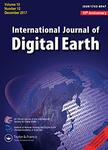Evaluation of nine machine learning methods for estimating daily land surface radiation budget from MODIS satellite data
作者机构:The State Key Laboratory of Remote Sensing ScienceJointly Sponsored by Beijing Normal University and Institute of Remote Sensing and Digital Earth of Chinese Academy of SciencesBeijingPeople’s Republic of China Beijing Engineering Research Center for Global Land Remote Sensing ProductsInstitute of Remote Sensing Science and EngineeringFaculty of Geographical ScienceBeijing Normal UniversityBeijingPeople’s Republic of China Department of Geographical SciencesUniversity of MarylandCollege ParkMDUSA Beijing Engineering Research Center for Global Land Remote Sensing ProductsCollege of Global Change and Earth System ScienceBeijing Normal UniversityBeijingPeople’s Republic of China
出 版 物:《International Journal of Digital Earth》 (国际数字地球学报(英文))
年 卷 期:2022年第15卷第1期
页 面:1784-1816页
核心收录:
学科分类:0809[工学-电子科学与技术(可授工学、理学学位)] 08[工学]
基 金:supported by National Natural Science Foundation of China:[grant no 41971291,42090012] National Key Research and Development Program of China:[grant no 2020YFA0608704]
主 题:Net radiation energy balance mid-low latitude model comparison machine learning deep learning MODIS ERA5
摘 要:The all-wave net radiation(Rn)at the land surface represents surface radiation budget and plays an important role in the Earth s energy and water *** studies have been conducted to estimate from satellite top-of-atmosphere(TOA)data using various methods,particularly the application of machine learning(ML)and deep learning(DL).However,few studies have been conducted to provide a comprehensive evaluation about various ML and DL methods in *** on extensive in situ measurements distributed at mid-low latitudes,the corresponding Moderate Resolution Imaging Spectroradiometer(MODIS)TOA observations,and the daily from the fifth generation of European Centre for Medium-Range Weather Forecasts Reanalysis 5(ERA5)used as a priori knowledge,this study assessed nine models for daily estimation,including six classic ML methods(random forest-RF,adaptive boosting-Adaboost,extreme gradient boosting-XGBoost,multilayer perceptron-MLP,radial basis function neural network-RBF,and support vector machine-SVM)and three DL methods(multilayer perceptron neural network with stacked autoencoders-SAE,deep belief network-DBN and residual neural network-ResNet).The validation results showed that the three DL methods were generally better than the six ML methods except XGBoost,although they all performed poorly in certain conditions such as winter days,rugged terrain,and high *** had the most robust performance across different land cover types,elevations,seasons,and latitude zones,but it has disadvantages in practice because of its highly configurable implementation environment and low computational *** estimated daily values from all nine models were more accurate than the corresponding Global LAnd Surface Satellite(GLASS)product.



